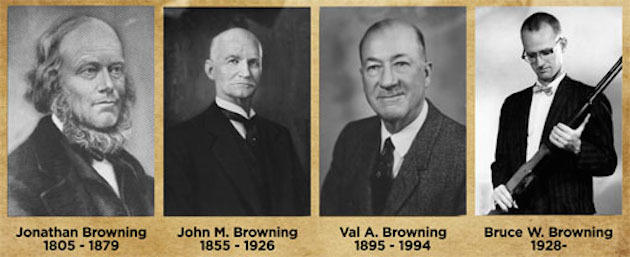Photo courtesy of the Browning Museum
John Moses Browning’s lifespan was arguably the golden age of firearm design, not just for his staggering number of patents, but because no one on either side of him in history has come close to matching it. Between his birth in 1855 and his death in 1926, Browning amassed a whopping 128 firearm patents. But no man is an island: Brownings have been building guns long before and long after John M.
The family’s reputation for firearms began long before the Buckmark emblem or the 1911. John M.’s father, Jonathan Browning, was born in Tennessee October 22, 1805. He began his worklife as a blacksmith, but later switched trades to become a gunsmith. His major success with firearms came while living in Quincy, Illinois, where he developed the harmonica gun detailed in a July 14 article by Sporting Classics Daily. He reportedly knew Abraham Lincoln during their overlapping time in Illinois and gave lodging to the then-lawyer on several occasions.
Jonathan eventually became an Illinois justice of the peace. It was in this judicial position that he came in contact with Mormons exiled by the governor of Missouri from that state in 1838. He became curious about the Mormon settlement in Nauvoo, Illinois, and visited, meeting Joseph Smith and eventually converting to the religion. He was consequently persecuted by Quincy residents and forced to flee westward with Brigham Young and other Mormons.
This exodus would influence Browning’s family and Browning Arms Company for several generations.
After leaving Illinois, Jonathan eventually settled in and opened up a gunsmithing shop in Ogden, Utah. He died and was buried there in June of 1879. His son’s company would later have its headquarters in the town, and many of his descendants have lived there as well.
John Browning was born to one of Jonathan’s three wives in 1855—the most famous of Jonathan’s nineteen children. His life has been explored at great length, and while it is incredibly interesting, it has been skipped for the purposes of this article. The firearm-family’s lineage continued with John M.’s son, Val Allen Browning.
Val
Val was born August 20, 1895, in Ogden. He studied law and engineering at Cornell, as well as serving in the US Army during World War I. He was a lieutenant in the 79th Infantry Division, using his father’s designs—like the Browning Automatic Rifle—to help defeat the Kaiser.
Val became the manager for Browning Arms Company’s Belgian manufacturing in 1920. He also served as the personal representative for John M. to Fabrique Nationale d’Herstal, which was producing firearms for Browning at the time.
Val married his wife Ann in 1924, and the two lived in Belgium until returning to the United States for Val to head Browning Arms in 1935.
Val followed in his father’s gargantuan footsteps and received several gun patents of his own. When John M. died in 1926, Val was tasked with completing the unfinished designs of his father. This contributed to a total of 48 design patents for him, including the Browning Superposed shotgun and Browning Hi-Power pistol.
Val died May 16, 1994 at the age of 98.
John Val
John Val Browning was born to Val and Ann in 1925. He was well-educated like his father, attending Brown Military Academy and MIT. He was drafted into the US Navy after graduating from MIT; World War II ended before he saw combat.
The war in Europe left Fabrique Nationale badly damaged, so Val and John Val made every effort to rebuild the factories there. When the facilities reopened, John Val worked to improve the quality and expand the scope of Browning products made there.
John Val served as the president of Browning Arms Company from 1960 until the company was sold to FN in 1977. He is the man responsible for Browning’s production of any and everything related to the outdoors. Under his leadership, Browning Arms expanded into fishing, clothing, boats, and other product categories.
He also began moving some of the company’s manufacturing from Belgium to Japan in search of higher quality at lower production costs.
He died March 18, 2003, following an illness. He was 77.
Bruce
Bruce W. Browning was born in 1928, two years after his grandfather John M.’s death. He is the son of Val and brother of John Val.
Like his relations before him, Bruce holds a number of patents, both for firearms and bicycles. He patented a trigger mechanism in 1967 and a bicycle transmission in 1991, among other designs.

